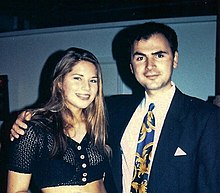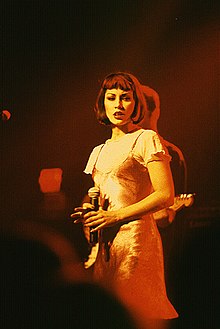

Fashion in the 1990s was defined by a return to minimalist fashion,[1] in contrast to the more elaborate and flashy trends of the 1980s. One notable shift was the mainstream adoption of tattoos,[2] body piercings aside from ear piercing[3] and, to a much lesser extent, other forms of body modification such as branding.
In the early 1990s, several late 1980s fashions remained very stylish among men and women. However, the popularity of grunge and alternative rock music helped bring the simple, unkempt grunge look to the mainstream by that period. This approach to fashion led to the popularization of the casual chic look, which included T-shirts, jeans, hoodies, and sneakers, a trend which would continue into the 2000s. Additionally, fashion trends throughout the decade recycled styles from previous decades,[4] most notably the 1950s, 1960s and 1970s.
Unlike the 1980s, when fashion with volume was commonplace, the 1990s was more characterized as time when fashion was decidedly low maintenance.[5] The 1990s was also time when more people began to value fashion as an intellectual form.[6] During this period, alternative fashion strategies become part of the commercial format.[7] Resistance to generally accepted fashion trends became one of the basic principles of fashion in the 1990s.[8] Elements of deconstruction in costume became an important element of commercial fashion.[9]
Due to increased availability of the Internet[10] and satellite television outside the United States, plus the reduction of import tariffs under NAFTA, fashion became more globalized[11] and homogeneous in the late 1990s[12] and early 2000s.[13][14]
- ^ Mower, Sarah (2010-09-09). "The return to 1990s minimalist fashion - Telegraph". fashion.telegraph.co.uk. Retrieved 2023-07-15.
- ^ "Bad fads: Tattoos". Archived from the original on 2011-11-28. Retrieved 2011-11-30.
- ^ "Body piercings and Tattoos". Archived from the original on 2012-04-24. Retrieved 2011-11-30.
- ^ Evans, Caroline; Fineberg, Jonathan David (2004). Christo and Jeanne-Claude: On the Way to The Gates, Central Park, New York City. Yale University Press. ISBN 978-0-300-10138-6.
- ^ Cerini, Marianna (April 29, 2020). "1990s fashion: A brief history of what we wore". CNN. Retrieved February 24, 2024.
- ^ Vasileva E.V. (2018) Deconstruction and Fashion: Order and Disorder // Fashion Theory: The Journal of Dress, Body and Culture, no. 4 (50), pp. 58–79.
- ^ Mendes V. de La Hay A. 20th Century Fashion. London: Thames and Hudson, 1999.
- ^ Wilcox C. Radical Fashion. [Exhibition catalogue]. London: V & A Publications, 2001.
- ^ Vasileva E.V. (2018)Deconstruction and Fashion: Order and Disorder // Fashion Theory: The Journal of Dress, Body and Culture, no. 4 (50), pp. 58–79.
- ^ Popsugar insights
- ^ Rabine, Leslie W. "Globalization and the Fashion Industry". LoveToKnow. Retrieved 2023-07-15.
- ^ Globalisation of fashion
- ^ "Global Fashion: A Window into Globalization | Global Currents". Retrieved 2023-07-15.
- ^ Molloy, Maureen; Larner, Wendy (2013-06-20). Fashioning Globalisation: New Zealand Design, Working Women and the Cultural Economy. John Wiley & Sons. ISBN 978-1-118-29576-2.
© MMXXIII Rich X Search. We shall prevail. All rights reserved. Rich X Search
